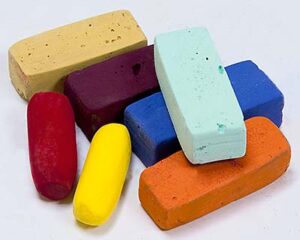About Pastels
As an art medium, pastels refer to durable sticks of colorful pigment used to make paintings. A pastel is an art medium made from a pure, powdered pigment which is combined with a minimum amount of binder and rolled into round or square sticks. It is not wet like most other forms of painting such as oils, acrylics or watercolors. A pastel painting is created by stroking this dry pigment across a rough, textured or “toothy” surface. The surface is usually an acid free abrasive or sanded paper or board. The “tooth” of the surface holds the pastel pigment in place.
These pigments are the same as the pigments used to produce all colored art media, including oil and acrylic paints. Pastels never crack, yellow or darken over time. When properly framed and securely hung, the particles will stay fixed in place indefinitely. Pastel is more permanent because it has no liquid binder that could oxidize over time, as long as it is applied to an archival support and properly framed under glass. Artists have used pastels since the Renaissance. Artists such as Degas, Manet, Renoir, Toulouse Lautrec, Whistler, Mary Cassatt and Wolf Kahn increased the popularity of pastel paintings when they made pastel their primary art medium.
Care of Pastel Art
Finished pastel paintings require protection, by framing under glass. The surface of a pastel painting should not be touched and should be protected from water. Framing under glass prevents damage from smudging the painting by touching it. It also prevents deterioration from environmental hazards such as air quality and humidity. As with any other art medium, it is best to avoid hanging artwork in a place with direct sun light. Use conservation glass or museum glass to protect against damage from ultraviolet light. The glass should not touch the artwork.
Pastel artwork should be protected from jarring and never be laid or carried in a face-down position. Both of these actions can cause some pastel dust to dislodge from the surface.
